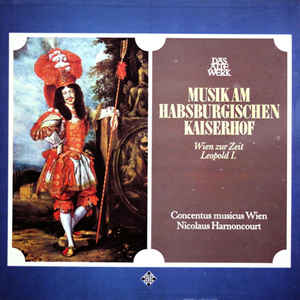 |
2 LP -
SAWT 9563/64-B - (p) 1970
|
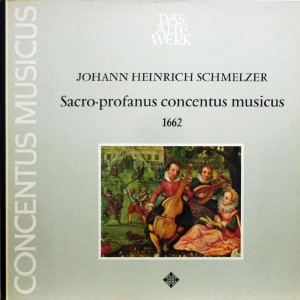 |
| 1 LP -
6.42100 AW - (p) 1970 |
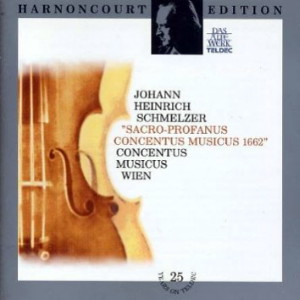 |
| 1 CD -
8.42100 XH - (c) 1989 |
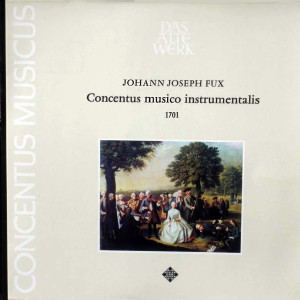 |
| 1 LP -
SAWT 9619-A - (p) 1970 |
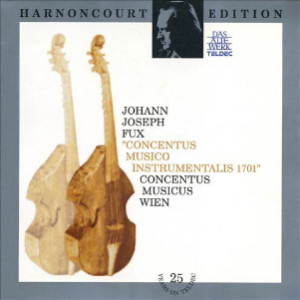 |
| 1 CD -
8.41271 XH - (c) 1989 |
|
| Musik am
Habsburgischen Kaiserhof - Wien zur Zeit
Leopold I. |
|
|
|
|
|
|
|
| Johann Heinrich
Schmelzer (1623?-1680) |
|
|
|
| - Sonata
Natalitia a 3 Chori für 2 Violinen, 3 Violen, 3
Piffari, Fagott, 2 Flöten, 3 Posaunen und
Bc. 1675 |
|
2' 50" |
A1
|
| - Sonata
II a 8; duobus Choris für Violine, Viola, Viola da
Gamba, Violoncello, Zink, 3 Posaunen und
Bc. "Sacro-profanus... 1662" |
|
5' 15" |
A2 |
- Sonata
a 4 "La Carolietta" für Violine, Zink, Posaune,
Dulzian und Bc. 1669
|
|
6' 15" |
A3 |
- Sonata
I a 8 für 2
Violinen, 2 Clarinen, 3 Gamben und Bc.
(Orgel und Gambe) "Sacro-profanus... 1662"
|
|
3' 52" |
A4 |
| - Sonata
a 3 für
Violine, Clarine, Posaune und Bc. (Violone
und Cembalo) |
|
4' 40" |
A5 |
| - Sonata
IV a 6 für 2
Violinen, 3 Viola da Gamba und Bc. (Gambe
und Cembalo) "Sacro profanus... 1662" |
|
4' 20" |
B1 |
| - Sonata
a 5 für 2
Violinen, Clarine, Fagott, Viola da Gamba
und Bc. (Cembalo) |
|
7' 00" |
B2 |
| - Sonata
a 3 für
Violine, Viola, Viola da Gamba und Bc.
(Violoncello und Orgel) |
|
5' 44" |
B3 |
| - Sonata a 3 Violini
für 3 Violinen und B.c.
(Violoncello und Cembalo) 1677 |
|
5' 44" |
B4 |
| Johann Joseph Fux
(1660-1741) |
|
|
|
| "Concentus
musico instrumentalis... 1701" |
|
|
|
- Serenada
à 8 für 3
Clarinen, 2 Oboen, Fagott, 2 Violinen,
Viola und Bc. (inizio)
|
|
23' 53" |
C |
| - Serenada
à 8 für 3
Clarinen, 2 Oboen, Fagott, 2 Violinen,
Viola und Bc. (fine) |
|
10' 47" |
D1 |
| - Rondeau
à 7 für
Violino piccolo, Fagott, Violine, 3 Violen
und Bc. |
|
4' 15" |
D2 |
| - Sonata
a Quattro für
Violine, Zink, Posaune, Dulzian und Orgel |
|
8' 40" |
D3 |
|
|
|
|
| Schmelzer |
Fux |
|
Don Smithers, Zink
|
Don Smithers,
Zink |
|
|
|
|
Concentus Musicus
Wien (mit Originalinstrumenten)
|
Concentus Musicus
Wien (mit Originalinstrumenten) |
|
| -
Josef Spindler, Clarintrompete |
-
Josef Spindler, Clarintrompete |
|
| -
Richard Rudolf, Clarintrompete |
-
Hermann Schober, Clarintrompete |
|
| -
Hans Pöttler, Barocktrompete |
-
Günther Spindler, Clarintrompete |
|
| -
Ernst Hoffmann, Barocktrompete |
-
Jürg Schaeftlein, Barockoboe |
|
| -
Andrea Wenth, Barocktrompete |
-
Karl Gruber, Barockoboe |
|
| -
Otto Fleischmann, Dulzian,
Barockfagott |
-
Otto Fleischmann, Dulzian,
Barockfagott |
|
| -
Jürg Schaeftlein, Barockoboe |
-
Milan Turkovic, Dulzian,
Barockfagott |
|
| -
Karl Gruber, Barockoboe |
-
Hans Pöttler, Barockposaune |
|
| -
Bernhard Klebel, Barockoboe |
-
Alice Harnoncourt, Barockgeige |
|
| -
Leopold Stastny, Renaissanceblockflöte |
-
Peter Schoberwalter, Barockgeige |
|
| -
Helga Tutschek, Renaissanceblockflöte |
-
Wilhelm Mergl, Barockgeige |
|
| -
Alice Harnoncourt, Barockgeige |
-
Walter Pfeiffer, Barockgeige |
|
| -
Walter Pfeiffer, Barockgeige |
-
Josef de Sordi, Barockgeige |
|
| -
Peter Schoberwalter, Barockgeige |
-
Kurt Theiner, Barockgeige |
|
| -
Josef de Sordi, Barockgeige |
-
Nikolaus Harnoncourt, Tenorviola |
|
| -
Stefan Plott, Barockgeige |
-
Hermann Höbarth, Barockcello |
|
| -
Kurt Theiner, Tenorbratsche |
-
Eduard Hruza, Violone |
|
| -
Nikolaus Harnoncourt, Tenor und
Baß Viola da Gamba |
-
Herbert Tachezi, Orgel, Cembalo |
|
| -
Elli Kubizek, Baß Viola da Gamba |
|
|
| -
Hermann Höbarth, Barockcello |
|
|
| -
Eduard Hruza, Violone |
|
|
| -
Herbert Tachezi, Orgel, Cembalo |
|
|
|
|
| Nikolaus
Harnoncourt, Leitung |
|
|
Luogo
e data di registrazione
|
| Casino Zögernitz,
Vienna (Austria) -
marzo, giugno e settembre 1969 |
|
Registrazione
live / studio
|
| studio |
Producer
/ Engineer
|
Wolf
Erichson
|
Prima Edizione CD
|
Teldec
"Das Alte Werk" - Harnoncourt Edition 25
Jahrs on Teldec - 8.42100 XH - (1 cd) -
45' 40" - (c) 1989 - ADD - Schmelzer
Teldec "Das Alte Werk" - Harnoncourt
Edition 25 Jahrs on Teldec - 8.41271 XH
- (1 cd) - 47' 35" - (c) 1989 - ADD -
Fux
|
Prima
Edizione LP
|
Telefunken "Das
Alte Werk" - SAWT 9563/64-B
- (2 lp) - 45'
40"
+ 47' 35"
- (p) 1970
Telefunken "Das Alte Werk"
- 6.42100 AW - (1 lp) - 45' 40" - (p)
1970 - Schmelzer
Telefunken "Das Alte Werk"
- SAWT 9619-A - (1 lp) - 47' 35" - (p)
1970 - Fux
|
|
|
Notes
|
Music At
The Imperial Hapsburg
Court
That
Vienna was already a center
of music in the baroque
period is probably chiefly
due to the extraordinary
enthusiasm shown by several
Hapsburg emperors for music.
In the case of Leopold I,
Austria’s baroque emperor
par excellence, enthusiasm
grew steadily into
fanaticism. This strange
man, who was emperor for
nearly fifty years, was by
no means a born ruler. Since
he was sickly and weak, had
a strong brother (Ferdinand
IV) and was furthermore
highly pious, he was
educated for the priesthood.
The sudden death of his
brother thus forced ihm into
a role for which he was
completely unprepared.
Nonetheless, or perhaps for
just that very reason and
despite all of its dissonant
tones, the period of his
reign was thoroughly
fruitful and in no wise less
successful than that of his
brilliant French
counterpart, Louis XIV,
whose reign was just about
as long. Leopold was not at
all war-like. A lovely
concert meant more to him
than winning a battle. His
generals complained that,
although he had no money for
the army, he still gave out
huge sums for his opera
performances. - Since court
life was more or less a
public affair, every
provincial nobleman tried to
emulate the customs and
fashions of the high
aristocracy. As a result, in
France and Germany there
were numerous small courts
that imitated Versailles in
its style of living and in
the architecture of its
palace and gardens. In
Austria and Bohemia
patronage of music was among
the things in which the
imperial court was imitated.
Even minor rulers maintained
court orchestras with
permanently employed
musicians. (Abraham à Sancta
Clara wrote in 1679: "...the
sound of trumpets and the
music that could be heard
coming out everywhere from
the courts and palaces of
the nobility always made
such pleasant noise that one
stopped in front of them: a
hole must have been made in
heaven, through which joy
fell peck-wise upon the city
of Vienna.") Splendid music
was also to be heard every
Sunday in the many churches
in Vienna and in the
convents and monasteries of
Lower Austria, that were
supposed to represent both
the ecclesiastical and
secular residences of God
during the baroque period.
Leopold not only had a
passionate ear for music, he
himself was also a composer,
and not a bad one. He wrote
masses, oratorios, dances,
German songs and many
additions to the
compositions of his court
musicians. Frequently he was
satisfied in inventing the
melody and left the
instrumentation to his court
composers Berthali or Ebner.
Although the Austrian state
coffers were always empty,
often even in debt, the
Italian musicians in the
court orchestra received
princely salaries. In every
respect they were the
predecessors of today’s
highly paid "star"
musicians.
Gottlieb Eucharius Rinck, a
captain in the imperial
army, wrote about Leopold
and his court orchestra: "The
emperor is a great artist in
music... if there was
anything in this world that
gave the emperor pleasure,
it was unmistakably good
music. It increased his joy,
it diminished his worries,
and one can say of him that
he never had any more
pleasurable hour among any
form of diversion than that
which a well-fitted concert
gave him. This could be seen
particularly in his rooms.
For when he, as was his
custom, changed residence
four times a year-namely,
from the castle to
Laxenburg, from there to the
'Favority'
and then to Ebersburg, there
was always a costly spinet
in each of the emperor’s
rooms, upon which the
emperor spent all of his
leisurely hours. His band
can well be called the most
perfect orchestra in the
world, and that is surely no
wonder wince the emperor
himself held the
examination. Whenever an
applicant was accepted, then
he had been judged according
to his merits and not by
inclinations... One can
judge from the number of
experienced musicians how
expensive they must have
been for the emperor. For
many of these people were
barons and were paid such
salaries that they could
live as befits their
station... Whenever the
emperor was in a concert of
his incomparable orchestra,
he enjoyed himself so much
that he gave unlimited
attention, such as if he
were hearing it for the very
first time... When a passage
came that particularly
pleased him, he closed his
eyes tightly so as to listen
with greater attention. His
ear was so keen that he
could detect among fifty
players which one had bowed
incorrectly."
Aside from the court capella
in Vienna there were
several other orchestras in
countries under Hapsburg
rule; they were built in
accordance with the personal
tastes of their respective
employers and enjoyed the
special attention of the
emperor. The most important
of these orchestras belonged
to the Archbishop of Olmütz,
Carl
Liechtenstein-Castelcorn.
This wealthy
prince of the Church had
built for himself a colossal
residence in Kromeřiz.
Apparently his preference in
music was
given over extremely to solo
performances. For several
years his famous court
orchestra was conducted by
Biber, who was one of the
foremost violinists of the
time. Biber’s successor was
the legendary court
trumpeter Vejvanovsky,
beside whom
there were excellent
trombonists, bassoonists and
flutists.
The string instruments were
ordered from the best
instrument-maker of the
time, Jacobus Stainer of
Absam. This orchestras - in
which not only German and
Austrian musicians were
engaged, but also many
Bohemians - was the chief
cause of Leopold’s many
visits to Kromeřiz.
Apparently the emperor also
took active part in the
music-making there from time
to time, for inserted
sections in a number of
compositions found there
were composed by him.
European music saw the
development of two main
stylistic currents in the
period following the Thirty
Years’ War: the French and
the Italian. The chief
characteristics of the
French style were its short
and clearly transparent
forms, extreme simplicity
and short movements;
ornamentation was strictly
schematic. The music was
primarily dance music, the
form of which has been
compared with the highly
rational and straight-line
forms of French palace and
garden architecture. Mainly
as a result of Lully’s
excessively strict
instructions, even the
manner of playing was
minutely prescribed, right
down to detailed rules for
bow-strokes. - On the other
hand, Italian music was
cheerful and outgoing;
instruments were always
expected to strive toward
emulation of the singing
voice; the musical forms
were expansive and splendid;
the string sound dominated.
Rich ornamentation was
improvised extemporaneously
by highly imaginative
interpreters. Hence, in
every respect, these two
musical styles provide a
faithful reflection of
Italian and French
temperaments. A blending of
the two was, at first,
considered impossible;
indeed, Italian musicians
refused to play French music
and vice versa. And rightly
so, incidentally, since in
those days music was thought
of as tonal conversation,
and one could not "converse"
musically in a language that
one neither had at command
nor liked.
In countries other than
France and Italy the
personal tastes of the
ruling prince dictated which
style of music was given
preference. The Viennese
court was, of course,
dominated by the Italians.
First of all, the emperor
took his political
opposition against France so
seriously that he did not
even allow the French
language to be spoken in his
presence. But then too, the
joyful spirit of Italian
music was far more
compatible to the Austrian
temperament than the
emphatically rational music
of the French. This meant
that for many generations
basically only Italian
musicians, singers and
composers could gain true
foothold in Vienna. The
advance of two "native"
Austrians, Schmelzer and
Fux, to the highest posts in
the imperial music
establishment must be
considered almost a minor
miracle. Naturally, the
Italian musicians at the
court wanted to keep "their"
orchestra as free as
possible of foreign
influence. Austrian, German,
Bohemian and French
composers were sometimes
able to ind favor at lesser
courts or with the Jesuits.
Extraordinary talents like
the harpsichordist Wolfgang
Ebner, the violinist
Heinrich Schmelzer and the
composer J. J. Fux had
chances of being taken into
the court orchestra only if
the emperor personally so
desired. But of course,
Italian music could not
maintain a pure monopoly in
Vienna. The city was so full
of music of every kind: in
addition to French music in
this melting pot of peoples,
Hungarian, Bohemian and
Austrian folk music was also
found, so that in the end
every style influenced and
permeated the others. As
early as the seventeenth
century a higly definite
Austrian style was in the
making, which injected
elements of all the other
styles into the Italian
form. A compromise that was
typically Austrian but, at
least in this case, highly
artistic.
On looking through Austrian
and Bohemian archives, one
finds such immense amounts
of music, especially from
the time of Leopold’s reign,
that it can scarcely be
imagined when all of it
could possibly have been
performed. In reality there
were even many more
compositions since, after
all, much has been lost in
the course of the subsequent
centuries. But the role of
music in the daily life of
that time was totally
different from its role
today. One played, exclusively,
music of what was then the
immediate present, was
consequently at home in the
musical idiom of the day so
that even the slightest
nuance was noticed and
probably also retained. Thus
it may be explained how
people did not want to hear
works several times, but
rather actually expected to
hear new compositions at
each occasion. That may well
have been connected with
their notion of instrumental
music as tonal conversation
- it surely would not be
toleranted that a speaker
repeat his lectures several
times. If one reflects that
the year has fifty-two
Sundays and that at a
music-loving court music was
performed four times a week,
one can somewhat reckon the
enormous and constant demand
for new music. In those
days, of course, every
trained musician was able to
compose music that was at
least technically flawless.
By no means could anyone,
nor did anyone want to,
consume true masterpieces
one right after the other;
as the Salzburg court
conductor G. Muffat
expressly demanded,
masterpieces always had to
be alternated with easily
comprehended and
uncomplicated pieces so as
not to overtax the listener.
----------
Heinrich
Schmelzer was
one of the most interesting
and original musicians of
his day. He grew up in an
army camp because his father
was an officer. Quite
probably it was there that
he received his first
impressions of music besides
regular violin instruction.
The Polish, Hungarian,
Croatian and Bohemian
soldiers of the Austrian
army, after all, had their
musicians with them, and
some were surely excellent
and virtuoso folk musicians.
All through his life
Schmelzer was most closely
attached to folk music; most
of his works reflect his
youthful impressions while
in the army camp. Before he
was
twenty years old his violin
technique must already have
been so good that he was
engaged as violinist in the
imperial court orchestra,
His unusual talent then soon
came to the attention of the
ernperor. He had to compose
the ballet music to nearly
all of the operas. Leopold
held him in such high esteem
that in 1679, he
made him his first non-Italian
conductor at the court. -
The works on this record are
taken in part from "Sacro-profanus
concentus
musicus" (a collection of
his works that was printed
in 1662) and in part from
the Kromeřiz
archives. The latter are so
extreme in their technical
and musical demands that
surely he had written them
especially for the virtuosi
of this orchestra. -
Formally speaking, all of
these one-movement sonatas
are in the Italian style.
The various sections with
differing rhythmic
signatures are not separated
from one another by
end-of-movement pauses, but
rather are joined together
without a break. At times
the form is concluded by a
reprise.
The Christmas Sonata "Natalitia"
is, despite its shortness, a
work of monstrous tonal
richness, with three choirs
- it was probably thought of
as pastoral music. A choir
of four piffari (oboes
with bassoon) and a choir of
two flutes and three
trombones answer the
five-part string choir that
is also supposed to be
provided in choirs.
Interestingly enough,
according to an explanatory
note in the instrument parts
the recorders may also be
replaced by soft zinks
- a further indication of
the dynamic possibilities of
the instruments of that time.
Sonata II in the
"Concentus" is written in
the old Venetian manner for
two separately placed
orchestral choirs; the
instruments used in the
choirs also reflect the old
Venetian style: one violin
and three violas in the
first choir against a zink
(cornetto) and three
trombones in the second
choir, with organ and
violone (double bass)
accompaning. The violone and
zink clearly have duties to
perform as concert soloists.
Alternation between the two
choirs is less in the form
of a dialogue than of
imitation and echo.
The sonata La Carioletta
is a typical Kromeřiz
work. It was composed in
1669, and its solos for
trombone and bassoon
(actually still a late form
of the dulciana) are decades
ahead of its time. Of
especial interest is the
bassoon part, that
diminishes the bass in
obligatory paraphrases. Such
extreme scorings prove the
dynamic flexibility and
homogeneity of the old
instruments time after time.
In the eight-part Sonata
I (of the Concentus)
the thematic motifs of the
trumpet are taken over by
the violins and gambas; the
middle section (without
trumpet) offers the
opportunity to change key
and to introduce
characteristic string
figures. The dance-like
final section is again
dominated by the valveless
trumpet.
It is true that the Sonata
for Violin, Clarino and
Trombone has come down
to us in Kromeřiz
without the
composer’s name; yet
the style of writing is so
very Schmelzer-like that I
personally hold it to be one
of his works. For all
practical purposes it is a
prelude and chaconne over a
step-wise descending bass
that had been repeatedly
used since Monteverdi. Every
instrument has solo
variations with technical
demands that border on the
limits of what is humanly
possible.
In Sonata IV (of the
Concentus) it can be noticed
most clearly that
Schmelzer’s inspiration
steemed
from eastern lolk music.
This work is pure Hungarian
gypsy music in which there
are many of the special
features and rhythms that
today are still identified
with that kind of music.
Another also extremely
difficult work
is thc Sonata a 5.
Once more the bassoon part
far exceeds the normal
requirenients for the bass
instrument. The themes of
this work
are determined by the
valveless trumpet. The two
violins are placed like a
choir against the two wind
instruments. In the middle
section each soloist has to
perform a "breakneck" solo -
a characteristic of nearly all Kromeřiz
Sonatas -
before they all join in to
play the dance-like closing
movement.
Although the Sonata a 3
has come down to us without
the name of its composer, it
is still impossible for me
to imagine its composer as
having been anyone other
than Schmelzer. The
instrumentation is subtly
worked out: each of the four
different string instruments
received a task that was
typical for Schmelzer. The
violin is the dominating
solo instrument, the
violetta (a viola) and the
garnba are juxtaposed like
two choirs. There is surely
a concrete program
underlying this piece, one
that is built on the
thoroughly complicated
rhythms in the bellringing
that returns twice. The
almost romantic melancholy
of the interludes, the rich
harmony and the themes of
the Allegro parts obviously
show a strong Hungarian
influence.
Completely unlike the other
works described up to this
point is the last Sonata
for Three Violins. In
this fugal work there are no
main or secondary parts; the
three solo violins are of
fully equal rank and
constantly pass the lead
from one to another. The
middle section is a harmonically
bold Adagio that, after a
short interlude, runs into
the final dance that is
written over a basso
ostinato.
----------
Johann
Joseph Fux,
too, brought
new folk-like
strains into
the
well-guarded
world of the
imperial court
orchestra. The
veil of
mystery
surrounding
the life
history and
musical
education of
Johann Joseph
Fux has still
not been
lifted. When
he was
approximately
thirty years
old, he
suddenly
appeared as a
finished
musician in
Vienna where
he worked
mainly as an
organist. The
emperor heard
him at the
home of a
nobleman and
named him
Court Composer
(the title was
created
especially for
him) in 1698.
Later he
entered the
court
orchestra and
was named
conductor of
the imperial
court
orchestra. -
As a composer,
Fux has not
been held in
the esteem he
merits. That
is probably
because he was
the author of
the famous
manual on
counterpoint
Gradus ad
Parnassum (the
work from
which the
\/iennese
classicists
still drew
their
technical
knowledge),
and because no
one was
willing to
believe that a
theoretician
could also be
a full-blooded
musician. Even
today, a
musician who
can express
himself on the
subject of
music is
usually
stamped a dry
theoretician.
The popular
picture of the
"artist" shows
him surrounded
by a magic
aureole;
intellect does
not fit into
that picture.
Fux personally
took another
view of
himself:
"...at the
time in which
l was not yet
in full use of
my reason, I
was swept away
by the
vehemence of
some urge that
could not
identify; it
directed all
of my thoughts
and feelings
toward music,
and even now I
am permeated
by an almost
miraculous
desire to
learn to
master it,
indeed, I am
pushed in that
direction as
if I had no
will of my
own; day and
night my ears
seem
surrounded by
sweet rnusical
tones, so that
I have no
reason to
doubt the
virtue of my
choice of
profession."
In
his "Concentus
musico
instrumentalis...
1701",
that he
dedicated to
Leopold's son
Joseph I,
he presented a
collection of
sonatas and
suites with
highly varying
instrumentations.
ln these works
the French and
Italian styles
pervade each
other and are
blended with
influences
that stem from
Austrian
folklore.
These works
must probably
also be
considered to
be typical of
Austria's
contribution
to the baroque
concert of
notions.
The Serenade
on this record
is the opening
piece of this
collection; it
is a suite
with sixteen
movements. The
versatile
employment of
the valveless
trumpet is
particularly
interesting:
in three
movements it
comes forth
festively
resounding, in
the other
movements its
line is
delicate and
cantabile. The
composer
apparently
wanted to
demonstrate
all of the
instruments
possibilities.
But even aside
from the
trumpet the
scoring is
remarltable.
There are solo
passages for
the oboes like
those that
loter appeared
in Handel's
Concerti
grossi. The
individual
movements are
in part free
fantasy forms
(Marche, Aria,
Aria, lntrada,
Finale), in
part dances or
the movements
of the French
overture suite
(Guigue,
Menuet
Ouverture,
Menuet l, ll,
Guigue, Aria
[Passepied]
Bourrée I, ll,
Rigadon,
Ciacona,
Guigue,
Menuet). But
Fux by no
means kept
strictly to a
formal pattern
in the
movements. To
the Guigue,
Ciacona and
Menuet he
wrote a free
solo part for
the trumpet:
elements of
peasant music
from his
native Styria
can be heard
repeatedly,
for example,
in several
minuets, but
especially in
the completely
unorthodox
Ciacona that
at times
sounds just
like a
Ländler.
The other two
pieces on this
recording were
found in the
Dresden State
Library; The Rondeau
a 7 was
included in
this
collection
chiefly for
its unusual
solo group. A
simple
dance-like
theme (that is
played by all
instruments
eleven times
with slight
rhythmic and
dynamic
variation)
forms a
framework for
the soli and
duets of the
violino
piccolo and
the bassaon.
The Sonata
a Quattro
requires
exactly the
same
instruments as
Schmelzer's
Carioletta, a
generation
later,
however; hence
it is
considerably
clearer and
smoother, a
masterpiece of
four-port
chamber musrc,
scored for
four entirely
different
sounding
instruments;
thus the
individual
voices always
remain
independently
clear and
maintain their
presence
throughout the
contrapuntal
structure.
Nikolaus
Harnoncourt
|
|
Nikolaus
Harnoncourt (1929-2016)
|

|

|
|